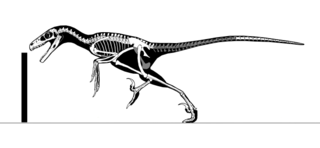
Saurornitholestes is a genus of carnivorous dromaeosaurid theropod dinosaur from the late Cretaceous of Canada (Alberta) and the United States.

Dinosaur Provincial Park is a UNESCO World Heritage Site situated a two hour drive east of Calgary, Alberta, Canada; or 48 kilometres (30 mi), about a half-hour drive northeast of Brooks.
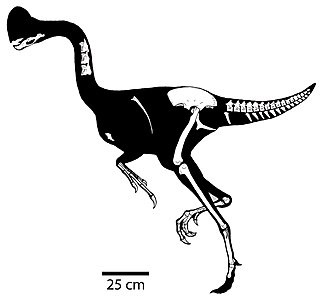
Chirostenotes is a genus of oviraptorosaurian dinosaur from the late Cretaceous of Alberta, Canada. The type species is Chirostenotes pergracilis.

Caenagnathus is a genus of caenagnathid oviraptorosaurian dinosaur from the late Cretaceous period. It is known from partial remains including lower jaws, a tail vertebra, hand bones, and hind limbs, all found in the Dinosaur Park Formation of Alberta, Canada. Caenagnathus measured about 2.5 m (8.2 ft) long and weighed about 96–100 kg (212–220 lb).

Zapsalis is a genus of dromaeosaurine theropod dinosaurs. It is a tooth taxon, often considered dubious because of the fragmentary nature of the fossils, which include teeth but no other remains.

Colepiocephale is a genus of pachycephalosaurid dinosaur from Late Cretaceous deposits of Alberta, Canada. It was collected from the Foremost Formation. The type species, C. lambei, was originally described by Sternberg, and later renamed by Sullivan in 2003. C. lambei is a domed pachycephalosaur characterized principally by the lack of a lateral and posteriosquamosal shelf, a steeply down-turned parietal, and the presence of two incipient nodes tucked under the posterior margin of the parietosquamosal border.
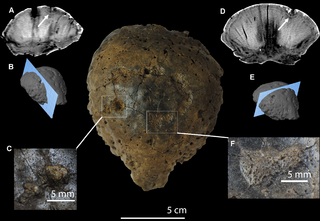
Hanssuesia is a genus of pachycephalosaurid dinosaurs from the late Cretaceous period. It lived in what is now Alberta and Montana, and contains the single species Hanssuesia sternbergi.

Gravitholus was a genus of pachycephalosaurid dinosaur from the late Cretaceous period. It was a pachycephalosaur, and like other pachycephalosaurids the skull roof formed a thick dome made of dense bone, which may have been used in head-butting contests over mates or territory. It lived in what is now Alberta, Canada, and was described in 1979 by W. P. Wall and Peter Galton. The type species is Gravitholus albertae.
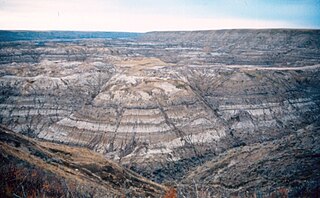
The Horseshoe Canyon Formation is a stratigraphic unit of the Western Canada Sedimentary Basin in southwestern Alberta. It takes its name from Horseshoe Canyon, an area of badlands near Drumheller.

The Bearpaw Formation, also called the Bearpaw Shale, is a geologic formation of Late Cretaceous (Campanian) age. It outcrops in the U.S. state of Montana, as well as the Canadian provinces of Alberta and Saskatchewan, and was named for the Bear Paw Mountains in Montana. It includes a wide range of marine fossils, as well as the remains of a few dinosaurs. It is known for its fossil ammonites, some of which are mined in Alberta to produce the organic gemstone ammolite.
Paleontology or palaeontology is the study of prehistoric life forms on Earth through the examination of plant and animal fossils. This includes the study of body fossils, tracks (ichnites), burrows, cast-off parts, fossilised feces (coprolites), palynomorphs and chemical residues. Because humans have encountered fossils for millennia, paleontology has a long history both before and after becoming formalized as a science. This article records significant discoveries and events related to paleontology that occurred or were published in the year 1914.
The Milk River Formation is a sandstone-dominated stratigraphic unit of the Western Canada Sedimentary Basin in southern Alberta, Canada. It was deposited in near-shore to coastal environments during Late Cretaceous time. Based on uranium-lead dating, palynology and stratigraphic relationships, deposition occurred between ~84.1 and 83.6 Ma.

Albertonykus is an alvarezsaurid dinosaur from the Maastrichtian-age rocks of the Horseshoe Canyon Formation of Alberta, Canada. It is known from forelimb and hindlimb remains from multiple individuals. All but two of the specimens come from a bonebed dominated by Albertosaurus, located at the top of Unit 4 of the Horseshoe Canyon Formation, dating to ~68.5 million years ago.
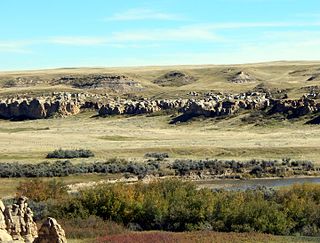
The Foremost Formation is a stratigraphic unit of Late Cretaceous (Campanian) age that underlies much of southern Alberta, Canada. It was named for outcrops in Chin Coulee near the town of Foremost and is known primarily for its dinosaur remains and other fossils.
Kirgizemys is an extinct genus of turtle from Early Cretaceous of China, South Korea, Mongolia, Russia and Kyrgyzstan.

The Fox Hills Formation is a Cretaceous geologic formation in the northwestern Great Plains of North America. It is present from Alberta on the north to Colorado in the south.
Unescoceratops is a genus of leptoceratopsid ceratopsian dinosaurs known from the Late Cretaceous of Alberta, southern Canada. It contains a single species, Unescoceratops koppelhusae.

Gryphoceratops is an extinct genus of leptoceratopsid ceratopsian dinosaur known from the Late Cretaceous of Alberta, southern Canada.

Albertavenator is a genus of small troodontid theropod dinosaur, known from the early Maastrichtian in the Cretaceous period. It contains a single species, A. curriei, named after paleontologist Phil Currie, based on a partial left frontal found in the Horseshoe Canyon Formation of Alberta during the 1990s. Albertavenator's discovery indicates that small dinosaur diversity may be underestimated at present due to the difficulty in identifying species from fragmentary remains.
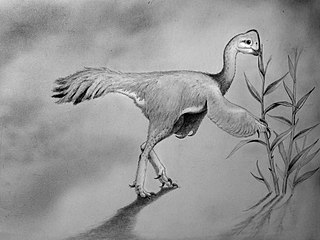
Leptorhynchos is an extinct genus of caenagnathid dinosaurs known from the Late Cretaceous Aguja Formation of west Texas United States. It lived about 80.5–72 million years ago. It is distinguished from its relatives Chirostenotes and Anzu by its smaller size, and by a more strongly upturned mandible, similar to that of oviraptorids. The specializations of the beak in Leptorhynchos and other caenagnathids suggest that they were herbivores. The species L. elegans has since been transferred to the genus Citipes, leaving only the type species L. gaddisi in the genus.















